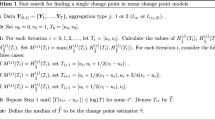Abstract
It is well-known that the fused lasso signal approximator (FLSA) is inconsistent in change point detection under the presence of staircase blocks in true mean values. The existing studies focus on modifying the FLSA model to remedy this inconsistency. However, the inconsistency of the FLSA does not severely degrade the performance in change point detection if the FLSA can identify all true change points and the estimated change points set is sufficiently close to the true change points set. In this study, we investigate some asymptotic properties of the FLSA under the assumption of the noise level \(\sigma _n = o(n \log n)\). To be specific, we show that all the falsely segmented blocks are sub-blocks of true staircase blocks if the noise level is sufficiently low and a tuning parameter is chosen appropriately. In addition, each false change point of the optimal FLSA estimate can be associated with a vertex of a concave majorant or a convex minorant of a discrete Brownian bridge. Based on these results, we derive an asymptotic distribution of the number of false change points and provide numerical examples supporting the theoretical results.

Similar content being viewed by others
Data availability
All the data in this paper are numerically generated and there is no data to be provided.
References
Anderson, T. W., & Stephens, M. A. (1997). The continuous and discrete Brownian bridges: Representations and applications. Linear Algebra and its Applications, 264, 145–171.
Fang, X., Li, J., & Siegmund, D. (2020). Segmentation and estimation of change-point models: false positive control and confidence regions. The Annals of Statistics, 48(3), 1615–1647.
Frick, K., Munk, A., & Sieling, H. (2014). Multiscale change point inference. Journal of the Royal Statistical Society Series B: Statistical Methodology, 76(3), 495–580.
Friedman, J., Hastie, T., Höfling, H., & Tibshirani, R. (2007). Pathwise coordinate optimization. The Annals of Applied Statistics, 1(2), 302–332.
Fryzlewicz, P. (2014). Wild binary segmentation for multiple change-point detection. The Annals of Statistics, 42(6), 2243–2281.
Fryzlewicz, P. (2020). Detecting possibly frequent change-points: Wild binary segmentation 2 and steepest-drop model selection. Journal of the Korean Statistical Society, 49(4), 1027–1070.
Groeneboom, P. (2011). Vertices of the least concave majorant of Brownian motion with parabolic drift. Electronic Journal of Probability, 16, 2334–2358.
Hoefling, H. (2010). A path algorithm for the fused lasso signal approximator. Journal of Computational and Graphical Statistics, 19(4), 984–1006.
Niu, Y. S., & Zhang, H. (2012). The screening and ranking algorithm to detect DNA copy number variations. The Annals of Applied Statistics, 6(3), 1306.
Olshen, A. B., Venkatraman, E. S., Lucito, R., & Wigler, M. (2004). Circular binary segmentation for the analysis of array-based DNA copy number data. Biostatistics, 5(4), 557–572.
Rinaldo, A. (2009). Properties and refinements of the fused lasso. The Annals of Statistics, 37(5B), 2922–2952.
Rojas, C. R., & Wahlberg, B. (2014). On change point detection using the fused lasso method arXiv preprint arXiv:1401.5408.
Son, W., & Lim, J. (2019). Modified path algorithm of fused lasso signal approximator for consistent recovery of change points. Journal of Statistical Planning and Inference, 200, 223–238.
Son, W., Lim, J., & Yu, D. (2023a). Path algorithms for fused lasso signal approximator with application to covid-19 spread in Korea. International Statistical Review, 91(2), 218–242.
Son, W., Lim, J., & Yu, D. (2023b). Tuning parameter selection in fused lasso signal approximator with false discovery rate control. Brazilian Journal of Probability and Statistics, 37(3), 463–492.
Tibshirani, R., Saunders, M., Rosset, S., Zhu, J., & Knight, K. (2005). Sparsity and smoothness via the fused lasso. Journal of the Royal Statistical Society: Series B (Statistical Methodology), 67(1), 91–108.
Wang, D., Yu, Y., & Rinaldo, A. (2020). Univariate mean change point detection: Penalization, cusum and optimality. Electronic Journal of Statistics, 14(1), 1917–1961.
Acknowledgements
This work was supported by the National Research Foundation of Korea (NRF) grant funded by the Korea government (MSIT) (NRF-2022R1A5A7033499 (Donghyeon Yu), NRF-2021R1A2C1010786 (Johan Lim) and NRF-2020R1F1A1A01051039 (Won Son)) and INHA UNIVERSITY Research Grant (Donghyeon Yu).
Author information
Authors and Affiliations
Corresponding author
Ethics declarations
Conflict of interest
All authors declare that they have no conflicts of interest to disclose.
Additional information
Publisher's Note
Springer Nature remains neutral with regard to jurisdictional claims in published maps and institutional affiliations.
Rights and permissions
Springer Nature or its licensor (e.g. a society or other partner) holds exclusive rights to this article under a publishing agreement with the author(s) or other rightsholder(s); author self-archiving of the accepted manuscript version of this article is solely governed by the terms of such publishing agreement and applicable law.
About this article
Cite this article
Yu, D., Lim, J. & Son, W. Asymptotic of the number of false change points of the fused lasso signal approximator. J. Korean Stat. Soc. (2024). https://doi.org/10.1007/s42952-023-00250-3
Received:
Accepted:
Published:
DOI: https://doi.org/10.1007/s42952-023-00250-3



